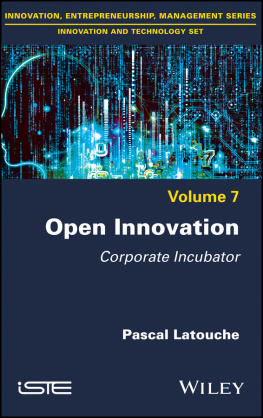
To my family, and in particular
Quentin, Lucas, Julian,
Genevive and Aude
To Chantal and Thierry
Innovation and Technology Set
coordinated by
Chantal Ammi
Volume 7
Open Innovation
Corporate Incubator
Pascal Latouche

First published 2019 in Great Britain and the United States by ISTE Ltd and John Wiley & Sons, Inc.
Apart from any fair dealing for the purposes of research or private study, or criticism or review, as permitted under the Copyright, Designs and Patents Act 1988, this publication may only be reproduced, stored or transmitted, in any form or by any means, with the prior permission in writing of the publishers, or in the case of reprographic reproduction in accordance with the terms and licenses issued by the CLA. Enquiries concerning reproduction outside these terms should be sent to the publishers at the undermentioned address:
ISTE Ltd
27-37 St Georges Road
London SW19 4EU
UK
www.iste.co.uk
John Wiley & Sons, Inc.
111 River Street
Hoboken, NJ 07030
USA
www.wiley.com
ISTE Ltd 2019
The rights of Pascal Latouche to be identified as the author of this work have been asserted by him in accordance with the Copyright, Designs and Patents Act 1988.
Library of Congress Control Number: 2018957896
British Library Cataloguing-in-Publication Data
A CIP record for this book is available from the British Library
ISBN 978-1-78630-324-0
Acknowledgments
Dedicated to Frigg Thank you for existing!
I have spent countless evenings and weekends meeting with developers, start-ups and many players in this fascinating ecosystem for the development of technological innovation.
No doubt it will be difficult to thank all those who have allowed me, voluntarily or involuntarily, to write this book, an extension of my doctorate started in November 2013 and conducted over four years.
Numerous people, whether family, friends and professionals, from all walks of life, have always known how to provide me with a whole new perspective on myself, and on my own perceptions of my surroundings.
I take this opportunity to personally thank them all here.
Preface
The sphere that I am approaching in this work is far from unknown to me. I have already practiced it for several years, as it is a passion of mine. In terms of passions, I have many others, such as those of science fiction and even antiquity. What is their relationship with the topic of this book?
In science fiction, there is almost always a hero smart enough to resolve an extraordinary situation. Antiquity is synonymous with mythical stories involving good guys, as well as bad monsters and cruel gods. Science fiction, like antiquity, projects me into a world which, far from making me forget what I feel, captures images of what I encounter, or even of what I imagine myself experiencing. Should I remind you about Troys story? Probably not. Why this metaphor, given the main theme of this book the corporate incubator? Here are some elements that I leave you to freely interpret through this division of roles
Ulysses is the manager of the corporate incubator. The Trojan horse is the structure of the business incubator. The latter carries within its belly the best start-ups. The Citadel of Troy is the big company. There is a certain hierarchy in Troy, with its King (the CEO), its princes (the Executive Board), its nobles (senior executives) and the people (the employees). It should be noted that the king and princes of Troy fervently desire that the horse, the offering of the Greeks (the ecosystem of the start-ups), enters the citadel. In any case, this is what they reveal to us. Finally, regardless of the real motives, we will have to find ways to deal with the Troy syndrome so that the horse is not a vehicle of fear and disorder for those who welcome him, but on the contrary is a source of peace and fertility. This is not a simple concept as the subtle mix of fear and fascination, inspired by start-ups, is indeed present in the minds of all Trojans, regardless of their rank.
This story, which began a long time ago, is still being written before your very eyes. I do not know how it ends. I confine myself to this work to simply explain the mechanisms of it. Happy reading!
Pascal LATOUCHE
October 2018
Introduction
I wanted to write this book aimed at the widest possible audience, as a natural extension of my personal doctoral research conducted from 2013 to 2017. In this book, I will try to make accessible the whys and hows, the fruits of the observations, analyses and interpretations I have made throughout this personal research, so as to somewhat raise consciousness of the phenomenon of the corporate incubator. For ease of writing, corporate incubation of start-ups will from now on be referred to by the abbreviation CI. The notions of managerial innovation, as well as open innovation which will also be mentioned will be referred to as MI and OI respectively.
To recognize that this story began several years ago, I might have entitled it Once Upon A Time There Was Corporate Incubation, but I preferred the title: Open Innovation: The Corporate Incubator. This sober title reflects my desire to understand OI by describing the reality of CI. I do not want to discuss the subject, as is so often done in the press: a subject for hype, where the communication teams of large groups provide many people to explain to us how it is cool, useful and highly strategic to work with start-ups within large groups. Although we cannot deny these aspects, the reality is that corporate incubation is far from being a fairy tale or a gently flowing stream for those who are in charge of this kind of set-up. Actors in corporate incubation will enact a process of uptake and transformation of products or services originating from start-ups, by deploying a particular know-how based on multiple interactions and trying to blaze a trail in the specific context of the industrial processes of large groups. To properly carry out this task, CI teams will demonstrate strong managerial resilience when faced with internal actors in the large group.
The purpose of the book, as you will realize, refers to my own experience only to decode what I see and what I hear. This is an important point, because the goal is not to project myself into the reality of what I see and what I hear, but in fact to decode it, in order to better understand the reality of the other, and doubtless in turn to better understand my own reality.
The mysteries of CI
In the wider sense, CI is a managerial innovation which, as I will show, is complex in that it mobilizes numerous internal actors in a large group and may consume those who are responsible for it. I use the term consume, at the risk of objections that the term is too strong. The approach demands a lot of energy and skill on the part of leaders. These latter must in fact open the minds of actors such as managers and collaborators towards new practices. This entails re-inventing the fabric of innovation, in fact creating a whole new setting, in the context of large groups as firms where the context for action is necessarily bureaucratic with little appetite for risk-taking. Start-ups are symbols of risks and uncertainties. CI may risk being perceived by some internal actors within large groups as a Trojan horse
Next page









